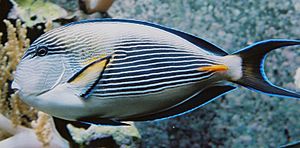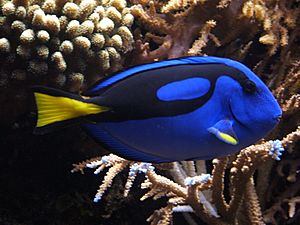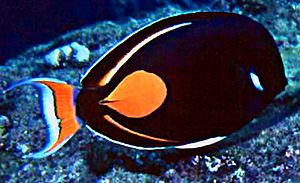Acanthuridae facts for kids
Quick facts for kids Acanthuridae |
|
|---|---|
 |
|
| Sohal surgeonfish, Acanthurus sohal | |
| Scientific classification | |
| Kingdom: | |
| Phylum: | |
| Class: | |
| Order: | |
| Suborder: | |
| Family: |
Acanthuridae
Bonaparte, 1832
|
Acanthuridae (say: Ah-kan-THOO-ri-day) is a family of amazing fish often called surgeonfish, tangs, or unicornfish. There are about 86 different kinds, or species, of these fish alive today.
These fish live in the ocean, mostly in warm, tropical areas. You can often find them swimming around colorful coral reefs. Many surgeonfish have bright colors, which makes them popular to keep in aquariums.
One really special thing about this fish family is that they have sharp, blade-like spines near their tail. These spines look a bit like a surgeon's scalpel, which is how they got the name "surgeonfish"!
What are Surgeonfish?
Surgeonfish are a group of marine fish. They are known for their unique body shapes and often vibrant colors. They play an important role in coral reef ecosystems. They help keep the reefs clean by eating algae.
Their Special Spines
The most famous feature of surgeonfish is the sharp spine on each side of their tail. This spine is usually folded down into a groove. But if the fish feels threatened, it can stick the spine out. This helps them defend themselves from predators. It's like a built-in knife!

How Big Do They Get?
Most surgeonfish are not very big. They usually grow to be about 15 to 40 centimeters (6 to 15 inches) long. That's about the length of a school ruler!
However, some types, like the Prionorus or Naso (unicornfish) groups, can grow much larger. Some unicornfish can even reach lengths of over 60 centimeters (2 feet)!
Images for kids
-
Eyestripe surgeonfish, Acanthurus dussumieri
-
Powderblue surgeonfish, Acanthurus leucosternon
-
Doubleband surgeonfish, Acanthurus tennenti
-
Kole tang, Ctenochaetus strigosus
-
Bignose unicornfish, Naso vlamingii
-
Bluespine unicornfish, Naso unicornis
-
Red Sea sailfin tang, Zebrasoma desjardinii
-
Orangespot surgeonfish, Acanthurus olivaceus, being cleaned by two Hawaiian cleaner wrasse, Labroides phthirophagus
-
Regal tang, Paracanthurus hepatus in an aquarium
See also
 In Spanish: Acantúridos para niños
In Spanish: Acantúridos para niños













